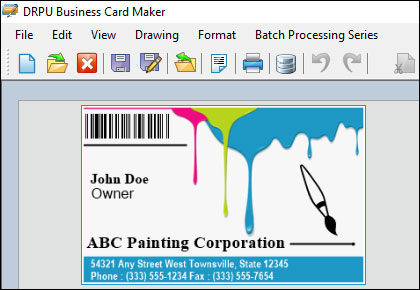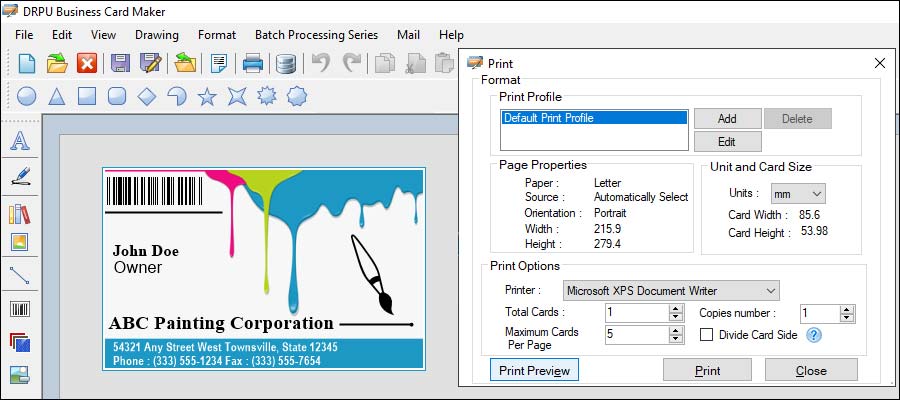Creating Custom Business Card Designs
Creating custom business card designs using business card maker software can be a quick and easy process using software tools in just few steps:-

-
Choose a Template
The first step in creating a custom business card design is to choose a template that matches your brand and industry. Most business card maker software tools offer a range of pre-designed templates that you can choose from.
When selecting a template, consider the color scheme, font style, and layout of the design. Look for a template that reflects your brand identity and is appropriate for your industry.
-
Customize the Design
Once you've selected a template, it's time to customize the design to fit your brand and style. Most business card maker software tools offer a range of customization options, including:
Adding your logo or images: Upload your logo or other images to the design, and adjust their placement and size to fit the layout.
Changing the font style and size: Choose a font style that matches your brand's visual identity, and adjust the size of the font to make your text stand out.
Adjusting the color scheme: Change the color of different design elements, such as the background, font, or icons, to match your brand's color scheme.
Adding additional design elements: Some software tools offer a range of graphics, icons, and shapes that you can add to your design to make it more visually appealing.
-
Add Your Contact Information
Once you've customized the design to your liking, it's time to add your contact information. This typically includes your name, job title, company name, phone number, email address, and website.
Most business card maker software tools allow you to add your contact information using a text editor or form. Make sure to proofread your text carefully to avoid any spelling or formatting errors.
-
Save and Export Your Design
After adding your contact information, it's important to save and export your design to a file format that can be easily printed or shared. Most business card maker software tools offer a range of export options, including:
PDF: This is a common file format for printing business cards, as it preserves the quality of the design.
JPG or PNG: These image file formats are useful for sharing your design online or via email.
Printing: Some software tools may offer printing services, allowing you to order your business cards directly from the software.
-
Print Your Business Cards
Once you've saved and exported your design, it's time to print your business cards. Most business card maker software tools allow you to print your design at home using a printer or at a professional print shop.
When printing your business cards, consider the paper type, finish, and size. Choose a high-quality paper stock that reflects the professionalism of your brand, and select a finish that suits your design, such as glossy or matte.
Features to Look for When Choosing a Business Card Maker Software
Choosing the right business card maker software can be a daunting task, given the sheer number of options available on the market. To help you make an informed decision, it's important to consider a range of factors and features when evaluating different software tools.
Some of the key features to look for when choosing a business card maker software:-
-
Ease of Use
The business card maker software should be easy to use, even for beginners who have little to no experience in graphic design. The user interface should be intuitive and user-friendly, with simple and straightforward navigation. Look for software that allows you to drag and drop design elements and make changes quickly and easily.
It's also important to consider the software's learning curve. If you're new to graphic design, look for software that offers tutorials or training resources to help you get started.
-
Integration with Other Tools
If you use other software tools for your business, it's important to consider whether the business card maker software integrates with them. Look for software that integrates with other design tools or CRM software, allowing you to import contact information directly into your business card design.
Some software tools may also integrate with social media platforms or email marketing software, making it easier to share your business card or use it as a marketing tool.
-
Templates and Designs
One of the most important features to consider when choosing a business card maker software is the range of templates and designs available. The software should offer a variety of customizable templates that are suitable for different types of businesses and industries. The templates should be modern, professional-looking, and easy to customize to fit your brand's visual identity.
Look for a software that offers a wide range of design elements such as graphics, icons, and shapes that can be easily incorporated into your design. Ideally, the software should allow you to upload your own logos and images, so you can create a unique and personalized business card that reflects your brand identity.
-
Customization Options
Customization options are another important feature to consider when choosing a business card maker software. The software should allow you to adjust the size, shape, and layout of your business card and offer a range of color options, font styles, and font sizes. Look for software that allows you to add your own text, logos, and images and adjust their placement and size.
In addition to basic customization options, some software tools may offer more advanced features such as the ability to add special effects or adjust image transparency. Consider your needs and the level of customization you require when evaluating different software options.
-
Export and Printing Options
After designing your business card, you'll need to export it to a file format that can be easily printed or shared. The business card maker software should offer a range of export options, including the ability to save your design as a high-quality PDF or image file.
It's also important to consider the software's printing options. Look for software that offers a range of printing options such as different paper types, finishes, and sizes. Some software tools may even offer printing services, allowing you to order your business cards directly from the software.
-
Pricing and Value
Finally, consider the pricing and value of the business card maker software. Some software tools may offer a free version with limited features, while others require a monthly subscription fee or one-time purchase. Consider your budget and the level of features and customization you require when evaluating different software options.
Also, consider the value you're getting for your money. Look for software that offers a range of features and customization options at a reasonable price. Compare pricing across different software tools to ensure you're getting the best value for your investment.
